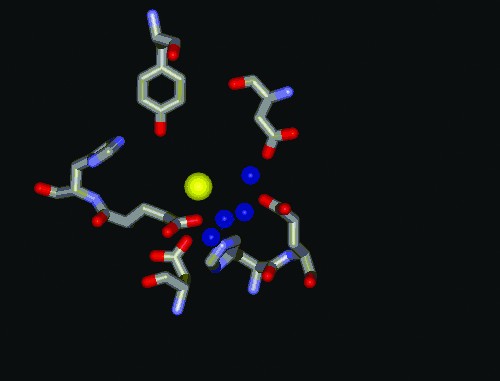 RESEARCHERS MODEL the structure of photosystem II’s oxygen-evolving complex.
RESEARCHERS MODEL the structure of photosystem II’s oxygen-evolving complex.Inside the brick walls of the innocuous-looking Cogswell Laboratory on the southern end of campus, the soft hum of sophisticated magnetic resonance machines can be heard day and night. The Lakshmi Lab, headed by its namesake Dr. K. V. Lakshmi, spearheads the work of the Baruch ’60 Center for Biochemical Solar Research. Its goal is to advance the world’s progress toward reliable, renewable sources of fuel production. Keeping in mind the Kardashev scale of measuring a civilization’s level of technological advancement, Dr. Lakshmi and her lab have looked to the sun. In an attempt to improve the inefficient conversion of light energy to electrical energy that already exists in photovoltaic cells, they have looked to the vastly more efficient process of photosynthesis.
Although the process of photosynthesis is understood fairly well, surprisingly little is known about exactly how the molecules regulate the high-energy proton transfers, electron transfers, and proton-coupled electron transfers involved in splitting water into oxygen and usable energy. The Lakshmi Lab is focused on understanding the structure and assembly of the protein complex photosystem II, which is known to be a vital light-induced photochemical intermediate of the photosynthetic reaction. The lab has been developing novel pulsed electron paramagnetic resonance and nuclear magnetic resonance spectroscopy methods to study the water-splitting chemistry of the protein complex.
Understanding the process is of paramount importance to the design and implementation of synthetic catalytic systems for solar fuels production, which is the end goal of the research. Researchers at the lab theorize that the creation of synthetic multinuclear manganese catalysts for water oxidation could stimulate a worldwide shift towards the research and development of a new generation of bio-inspired photovoltaic devices. There is a steady rise in the percentage of the world population that is a part of the energy grid, and anyone can see that rate of energy consumption as a species is already skyrocketing toward a point in time, during our generation’s lifetime or perhaps the next, where our way of life will no longer be possible.
The interdisciplinary research of the Lakshmi Lab combines biology and genetics to study specific types of algae and plants, biochemistry to study protein complexes and molecular catalysts, quantum chemistry to study proton, electron, and proton-coupled electron transfers, synthetic inorganic chemistry to study possibilities of manmade photosynthetic compounds, pulsed electron paramagnetic resonance and solids nuclear magnetic resonance spectroscopy to study the mechanisms of light-driven charge transfer reactions in natural and synthetic photosynthetic systems.
